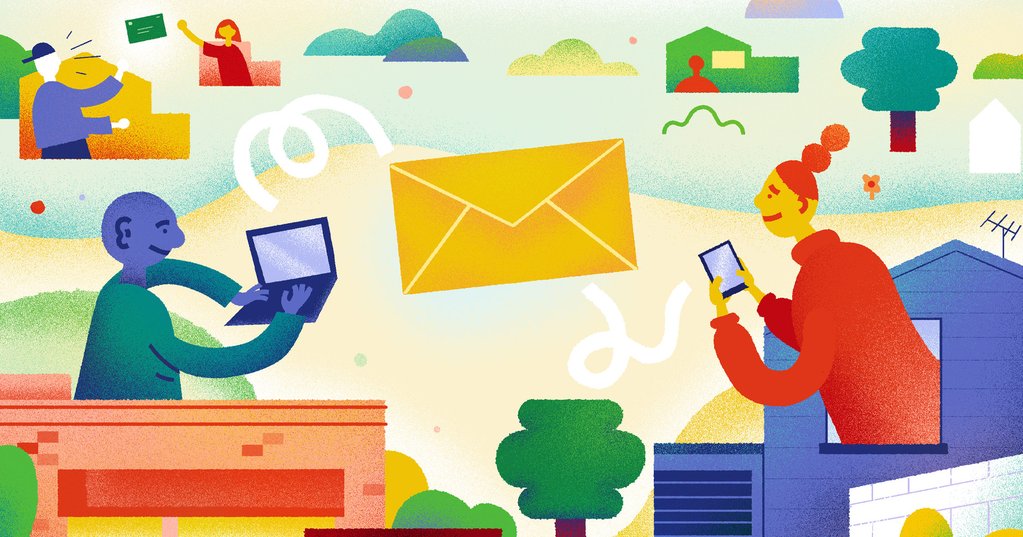Tech commentators love to declare—with seemingly great confidence—that email is on its last legs. But we’re willing to wager one look at your inbox is enough to prove “you’ve (still) got mail.”
In fact, many small businesses are showing a renewed interest in email marketing as a way to reach their customers with relevant, personalized messages at the right time—without needing permission from the internet’s increasingly restrictive gatekeepers. Plus, email has seen consistently healthy growth in global users with no signs of slowing down.
Whether you're just getting started with email marketing or dreaming up your next big campaign, our guide reveals what email campaigns work best and how to make the most of every broadcast.
- What is email marketing?
- Why email marketing is key to ecommerce success
- Getting started with email marketing
- Types of email marketing campaigns to send
- Foundational metrics to track email marketing performance
- Lifecycle automation: the next level of email marketing
What is email marketing?
Email marketing is the practice of sending marketing messages to prospective and current customers via email in order to sell, educate, or build loyalty.
Email is an “owned” digital marketing channel—that is, the sender fully controls the content and distribution—and typically works best when used to send personal, relevant messages to segmented lists of recipients. Email is an especially important tool in relation to ecommerce, where it’s used for sending transactional, promotional, and lifecycle messages (which we’ll cover in more detail below).
Why email marketing is key to ecommerce success
The reality of website traffic, even highly targeted traffic, is most new visitors to your store will never return—unless, that is, you do something to keep them coming back.
Building an email list and sending compelling broadcasts gives you a way to retain the traffic you worked so hard to earn by providing subscribers with an incentive to stay in touch.
If your ecommerce business hasn’t taken the time to adopt email marketing, you’re likely leaving money on the table. To prove it, here are five reasons to consider employing email in your marketing mix.
1. Email lets you build ongoing customer relationships
Search engines and social media platforms are great for getting discovered by future customers, but email remains the best way to maintain and strengthen existing relationships over time.
Email is one of the best channels for maintaining and strengthening customer relationships over time.
According to a Nielsen study, 66% of online consumers prefer to buy new products from brands they are familiar with. Email also plays a pivotal role in encouraging a customer’s second purchase and beyond. Having customers return is important for many businesses because it keeps their average cost of acquiring a customer down.
2. Email is incredibly effective at driving sales
A 2018 study from the DMA found that for every dollar spent on email marketing, businesses can expect an average return of $32.
Of course, certain businesses (and products) pair especially well with email marketing, and returns are never guaranteed. But over the years, similar research has painted the same picture: email is a high-performing channel that frequently outperforms the alternatives.
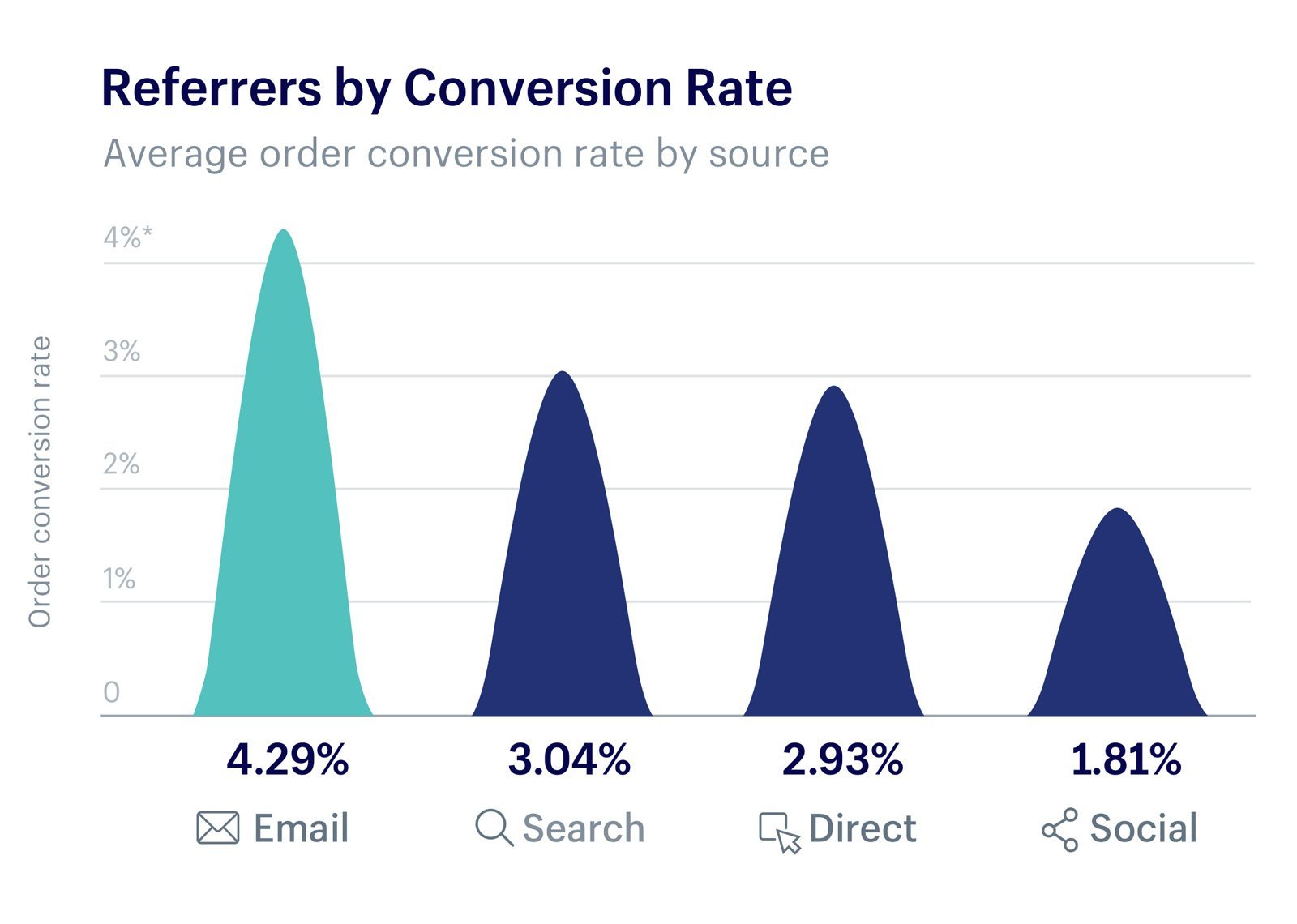
What’s more, a 2018 report from Emarsys showed roughly 80% of businesses rely on email as their primary channel for acquisition and retention. Email marketing is relatively unique in its ability to drive the first sale as well as unlock more revenue from your most valuable customers.
3. Email can affect the three main growth multipliers
Marketer Jay Abraham was one of the first to popularize the idea that there are only three ways to grow revenue: increase the total number of customers (C), increase the total number of purchases per customer (purchase frequency, or F), or increase the average order value (AOV).
Most entrepreneurs pursuing an acquisition “silver bullet” usually end up disappointed and discover that acquiring customers can quickly get expensive. Email marketing offers a viable way out of the acquisition rat race because it can influence all three growth multipliers at the same time:
- Automated welcome and abandoned cart emails can increase conversion rates (C)
- Bounce back or win-back campaigns can increase a customer’s number of purchases (F)
- Lifecycle campaigns and broadcasts can automatically highlight high-value products to the right customers (AOV)
Systematic focus on all three areas will further compound your results, and that’s one of the biggest reasons why it's worth creating a deliberate email marketing strategy when growing an ecommerce business.
4. Email isn’t influenced by third-party gatekeepers
One aspect of email marketing that continues to grow in importance is that email isn’t subject to the whims of centralized platforms, where unplanned tweaks to algorithms can completely derail a distribution strategy.
In contrast, organic reach for Facebook pages has been declining since 2013, as the platform continues to focus its News Feed on promoting content from friends and family. Similarly, climbing the search rankings in Google is only getting harder, with advertisements and answer boxes resulting in a noticeable increase in no-click searches, especially on mobile. More than ever, if you want to reach your customers on these platforms, you may be forced to pay—and those costs are increasing.
Getting started with email marketing
Even the best email marketing strategy begins with choosing an email marketing service, establishing a plan to generate new subscribers, and understanding how to send emails legally.
Choose an email service provider
The first step in getting started with email marketing is to choose email marketing software through which you’ll begin building your list. There are many robust and cost-effective email marketing tools to choose from, so don’t get caught up trying to pick one that’s “perfect.” You can always switch providers down the line. Instead, pick a well-reviewed solution that fits your needs (e.g., pricing, drag-and-drop editors, email templates, etc.), then start emailing and driving sales.
Klaviyo, Conversio, Jilt, and Omnisend are some of the email marketing tools that integrate with Shopify we’ve seen new merchants have success with. Other popular solutions include Constant Contact and GetResponse. (You can get our full list of recommendations on the Shopify App Store.)
Learn more: The Best Email Marketing Services for Ecommerce Stores
Start building your email list
Ask any online business owner about their biggest marketing regret and many will tell you it’s that they didn’t start collecting email addresses from Day 1. Learn from this frequent mistake and start growing your list of subscribers as soon as you can, even before you launch your business.
A key thing to know before you begin building your email list is that you need permission to follow up with prospects and customers over time. To do that, subscribers need to “opt-in” to hear from you, and there are a number of ways you can encourage them to do so.
1. Set up a pre-launch page
Although real product validation requires paying customers, having an engaged email list full of potential customers is a close second.
Before you officially open your doors to paying customers, set up a basic landing page on your domain that invites visitors to stay informed by entering their email address. Don’t beg—write copy that describes what’s exciting about your upcoming product and offer strong incentives for early adopters where it makes sense (e.g., early-bird customers get 20% off on launch day).
2. Collect emails from sales and customer accounts
Customer accounts are valuable to businesses because they require shoppers to share relevant information—including their email address—and make purchasing history easier to track. The downside is many customers find it frustrating to create an account for a single shopping destination.
A useful compromise is providing the option to create an account after a customer’s first order has been placed. If you're using Shopify, customer accounts are optional, and you can send customers direct invitations encouraging them to activate an account after they’ve completed a purchase.
3. Place opt-in forms across your site
To grow your list, you need to ask people directly to sign up. So it stands to reason the best place to ask is where they’re already engaged, on relevant pages across your online store. Just be sure you’re not compromising your site’s design and leaving a bad first impression. Try placing your signup forms in these locations first:
- Your header, navigation, or footer. Although these locations will likely have lower overall conversion rates than a dedicated landing page, over time, the number of subscribers they generate will add up, especially if you provide an incentive like a first-time customer discount.
- Your About Us page. As marketer Bob Frady writes, “Customers don’t sign up for email, they sign up for your brand.” Email is merely a mechanism—your brand and offers are the backbone of your value proposition and a subscriber’s incentive to give you their email. If your About Us page is doing its job selling your company’s vision, it’s a great place to encourage customers to subscribe.
- Your blog or resource pages. If you’re using content marketing to educate your customers and rank in search engines, you’re already attracting prospects looking for information, so including a targeted opt-in form inline or in the sidebar of your blog can help move them down the funnel.
- A pop-up form. Try setting pop-ups to trigger when a visitor is slipping away, so you don’t interrupt their experience. Exit-intent pop-ups only show when a visitor moves their mouse off your website toward the search bar or back button, giving you a second chance to collect their email. Try apps like Privy, Sumo, or JustUno on the Shopify App Store to create your pop-ups.
4. Accelerate signups with lead magnets
Too often, online businesses assume the idea of receiving a newsletter is a compelling enough reason for people to subscribe. Marketing is about messaging and measurement, and “get our weekly emails” is not a compelling message.
To up the ante, consider creating a real offer as an added incentive for visitors to share their email. Here are a few tried-and-true approaches:
- Offer exclusive deals and discounts. Be careful with discounts: they can hurt your margins by coaching customers to always wait for deals. Discounts do often make financial sense if they keep a prospect you were going to lose anyway, which means they can be a solid motivator to get customers to leave their email.
- Run sweepstakes or a contest. Although contests can potentially bring in a lot of signups, the inherent downside is the person you’ll attract is looking for free stuff. Use a giveaway to break through the noise, or to jumpstart your list, but don’t rely on them to grow an engaged audience for the long term. Check out contest apps on the Shopify App Store.
- Access to educational content. Certain consumer products benefit from sharing additional context with customers. As developer Kathy Sierra argues in her book Making Users Awesome, no one wants to be “good at cameras,” they want to take beautiful photographs. Consider producing a free piece of content that contains tangible value for your target customers and will put them into a buying frame of mind. The best converting lead magnets offer something visitors can immediately apply and highlight a gap your product can fill.

5. Ask for emails in person
There’s hidden value in less-scalable approaches to collecting emails, particularly the options available to you in the physical world. If you sell your products through pop-up shops, take one-off orders from friends, or already have a physical storefront, you’ll encounter a number of opportunities to ask customers for their email directly.
The same idea applies to physical calls to action: packaging inserts and small cards shipped with orders can include discounts or offers for customers who return to store—just set up a separate page that customers can access by entering the link from the insert into their browser.
Send emails legally
Email promotion is an example of “permission marketing”—a term coined by Seth Godin, marketer and bestselling author—which means people can opt in and out of their relationship with your brand as they please. The relationship you build with your email list needs to be based on permission; not just from a marketing standpoint, but a legal one too.
If you neglect the law, you could face serious fines. To start, familiarize yourself with the following rules and regulations:
- CAN-SPAM. The Controlling the Assault of Non-Solicited Pornography and Marketing Act. CAN-SPAM sets rules around commercial email.
- GDPR. The General Data Protection Regulation, is meant to protect personal data for individuals within the European Union.
- CASL. Canadian Anti-Spam Legislation. It helps protect Canadians while ensuring that businesses can continue to compete in the global marketplace.
Disclaimer: The material shared in this guide is for informational purposes only and does not constitute legal advice. If you have any specific questions about the legality around sending email, consult a lawyer who specializes in this area.
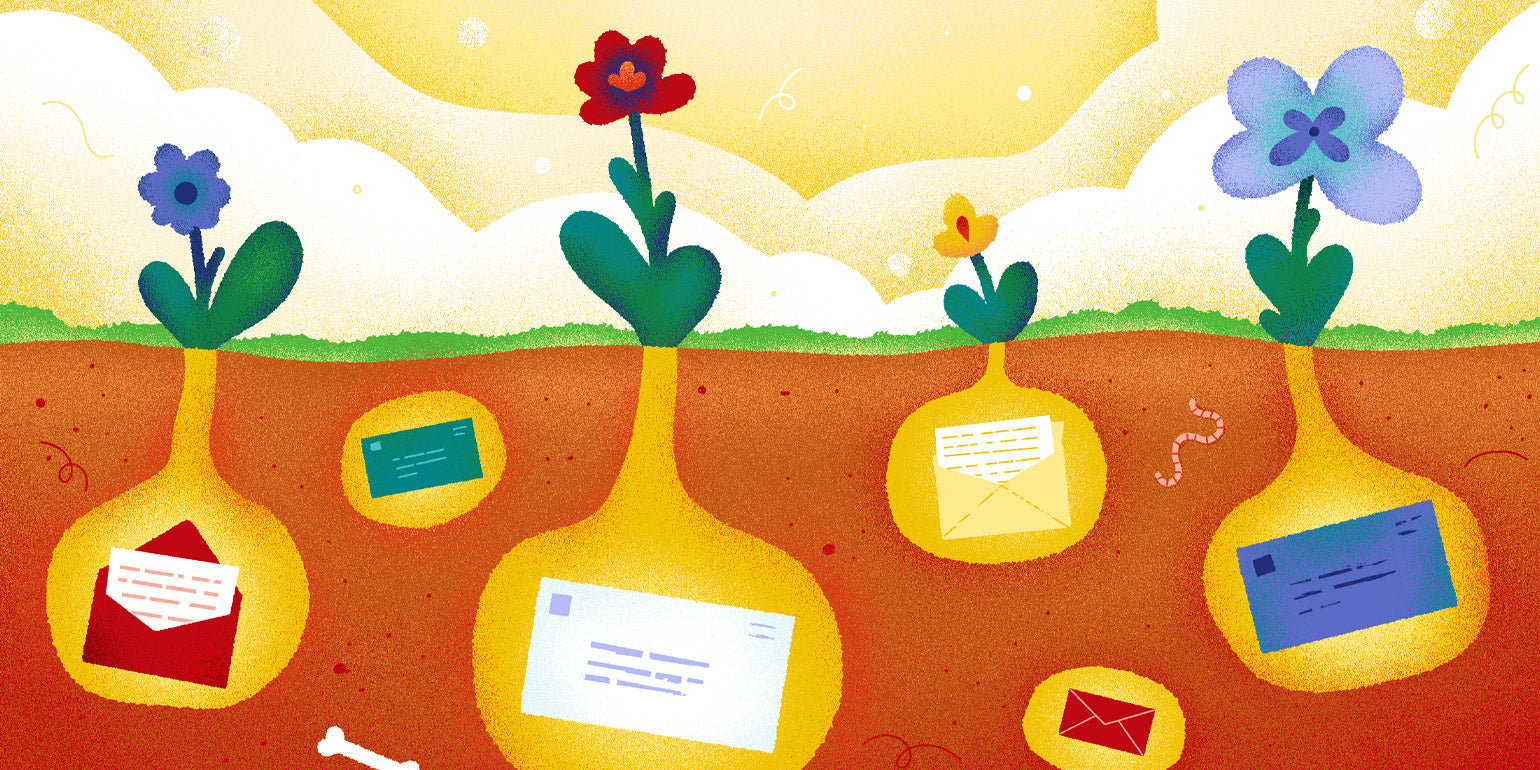
Types of email marketing campaigns to send
Sending irrelevant or unwelcome messages to the wrong people at the wrong time is a surefire way to squander email as a valuable marketing channel. So let’s talk about the different types of campaigns and how you can make them engaging to customers.
There are three core categories of ecommerce marketing emails: transactional, promotional, and lifecycle.
- Transactional emails are sent during checkout and other purchasing actions and are more functional in nature, sending key information to individual customers. Order confirmations, receipts, and order-shipped emails all fall within this category.
- Promotional emails are designed to raise awareness for a specific deal or (you guessed it) promotion. For example, a Black Friday Cyber Monday email, a Mother's Day gift guide email, a summer savings email, or a limited-time-only discount email would all fall under this category.
- Lifecycle emails, also known as “triggered” emails, are so named because they’re sent based on what action a shopper took and where that shopper is in the customer lifecycle. For example, a cart abandonment email only sends after a customer leaves products in their cart.
Learn more: 7 Automated Email Campaigns That Win Customers and Keep Them Coming Back
1. Transactional emails
According to a 2016 study by IBM, the mean unique open rate for transactional emails is 47.1%, nearly double that of the 21.6% open rate for non-transactional emails. The chasm is even wider for average engagement, with a mean unique click-through rate of 8.8% for transactional emails and just 3.3% for non-transactional emails.
Why the drastic difference? Transactional emails are not just expected; they’re anticipated. Customers seek them out. Because of their high engagement, you shouldn’t skimp on making your transactional emails great. Let’s start with a few basic transactional emails your store should send out.
Order confirmation and email receipts
The average open rate for an order confirmation email, or a receipt, can be as high as 70%–90%, depending on the industry. You’d be wise to use the near-guaranteed attention receipts receive as an opportunity to keep a customer after an initial sale.
First, however, you’ll want to ensure your email receipts answer the basic questions customers have: when they can expect to receive the order, what address you’re shipping to, and where they can ask questions. Only once the fundamentals are in place should you experiment with extras.
For repeat customers, try suggesting related products, or include the option for an add-on or accessory to their purchase before it ships. Dollar Shave Club sends an order confirmation email to monthly subscribers before their package ships, inviting them to add more items to their box.
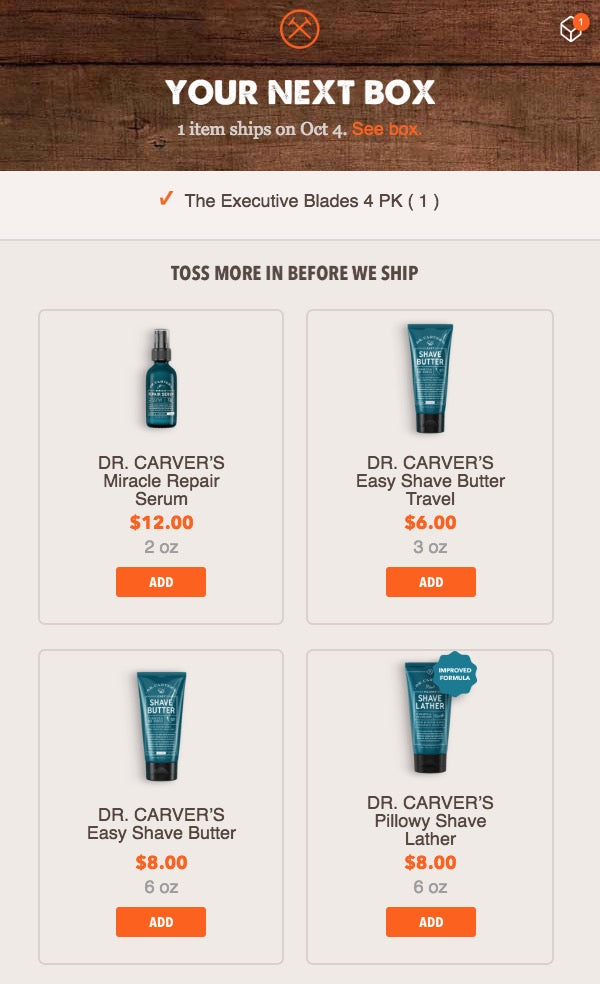
Ways to improve order confirmation emails
- Upsell related products by suggesting accessories, offer the option to buy the same product for a friend as a gift, or add the option for a subscription purchase.
- Offer a discount code or free shipping for a future purchase within a limited time frame. This is called a bounce-back offer and it’s one way the loss in revenue you’ll incur by giving a discount makes sense, because it’s often better to have the customer come back at a cheaper price than not at all.
- Ask the customer to join your community. If you’re selling a purely functional product, this may not work. But businesses that seek to have shared values with their customers should use their receipts as another avenue to get customers plugged into their community.
Shipping confirmation email
Shipping confirmation emails are sent once a package has been shipped. They’re valuable because your customer is already excited about receiving their order—they’re also an underused opportunity to get creative and delight your customers.
You can think outside the box in terms of converting more customers, too. How can you use the shipping confirmation email to drive action and deepen a customer’s relationship with your brand?
Tradesy uses its shipping confirmation email to promote its referral program, encouraging customers to gift their friends and family $20 off.

Shipping confirmation emails are especially effective when the CTAs are personalized to the customer’s purchase. For example, if a customer purchases a pair of men’s pants, product recommendations could focus on matching shirts and ties instead of less relevant apparel, like a full suit or women’s clothing.
Ways to improve shipping confirmation emails
- Make it easy for your customers to track their order. Include the expected delivery date and tracking number linked to the shipping company so people can click once to see exactly where their order is in the delivery process.
- Suggest the customer refer a friend by forwarding a link to the product they purchased. Incentivize word-of-mouth marketing by implementing a referral program with rewards.
- Include product suggestions that match a customer’s purchase. Make sure you’re asking shoppers to purchase something they’ll actually be interested in.
Learn more about how shipping confirmation emails can be a key part of subscription based email marketing.
Check-in email
Many brands neglect customer feedback at their peril. Fortunately, soliciting feedback can be as simple as sending a survey or a single question about the customer’s shopping experience.
You’ll want to send these requests after a customer presumably has received and used the product they ordered. Here's an example survey from Death Wish Coffee:
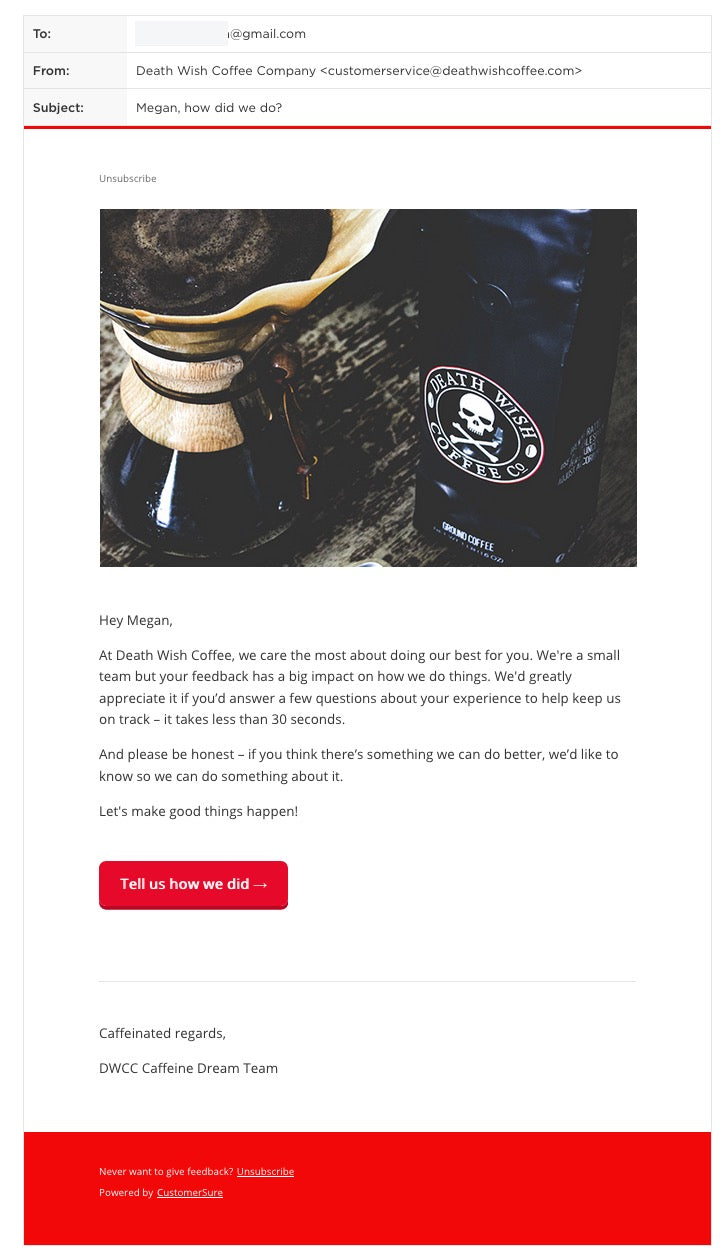
While Death Wish sends the customer to a third-party survey tool for feedback, many businesses will include the full survey in the email itself, often by using a rating system (e.g., “Rate your experience”). You can also send customers to a survey available on your store. This makes it easy to prompt a satisfied customer to start shopping once their review is complete.
What about those who are less than happy with their previous purchase? Follow up is essential here, first to prompt a response and next to figure out how you can improve the experience for future customers.
Ways to improve customer feedback emails
- Focus on customer satisfaction, not sales, so you can get your customers’ thoughts on their purchase. Track these metrics over time and look for actionable insights you can implement to improve your business over time.
- Consider placing the review/survey form on your website so the customer can see related offers and products after submitting their feedback.
- Include the review on the product page as user-generated content to boost future buyers’ confidence.
2. Promotional emails
Broadcast emails are sent to your entire list of subscribers or, more commonly, to a segment of your email list. Examples of broadcast emails include a new product release, monthly email newsletters, a time-sensitive promotion, seasonal deals, or a content update.
You can think of these emails as messages you send when you have something newsworthy to share, so carefully consider your underlying goal, offer, and the segment of subscribers.
New products (or services)
New products often are developed thanks to feedback from customers, so there’s no better place to begin when launching a product than with your subscribers. If your latest release appeals to a specific set of your customers, for example, you can segment your list based on previous purchases.
Time-sensitive deals
Create a time-sensitive promotion that relates to customers’ interests. Offer a discount on the same category of items they bought in the week before. Remember, when a sale is compelling, it’s best not to let overly clever copy get in the way.
Subscriber-only discounts
Whether you send a regular newsletter or set up a drip campaign about special promotions, you can always include discount codes to boost your subscribers’ motivation to make a purchase. Offering a feeling of exclusivity and membership is a great way to introduce emotion into your marketing.
Seasonal promotions
A traditional and effective form of email marketing is notifying subscribers of special offers based on upcoming holidays or the time of year. You might want to let your subscribers know about a Black Friday sale, an after-Christmas sale, or a spring clearance sale. You can also remind people about upcoming holidays, like Father’s Day.
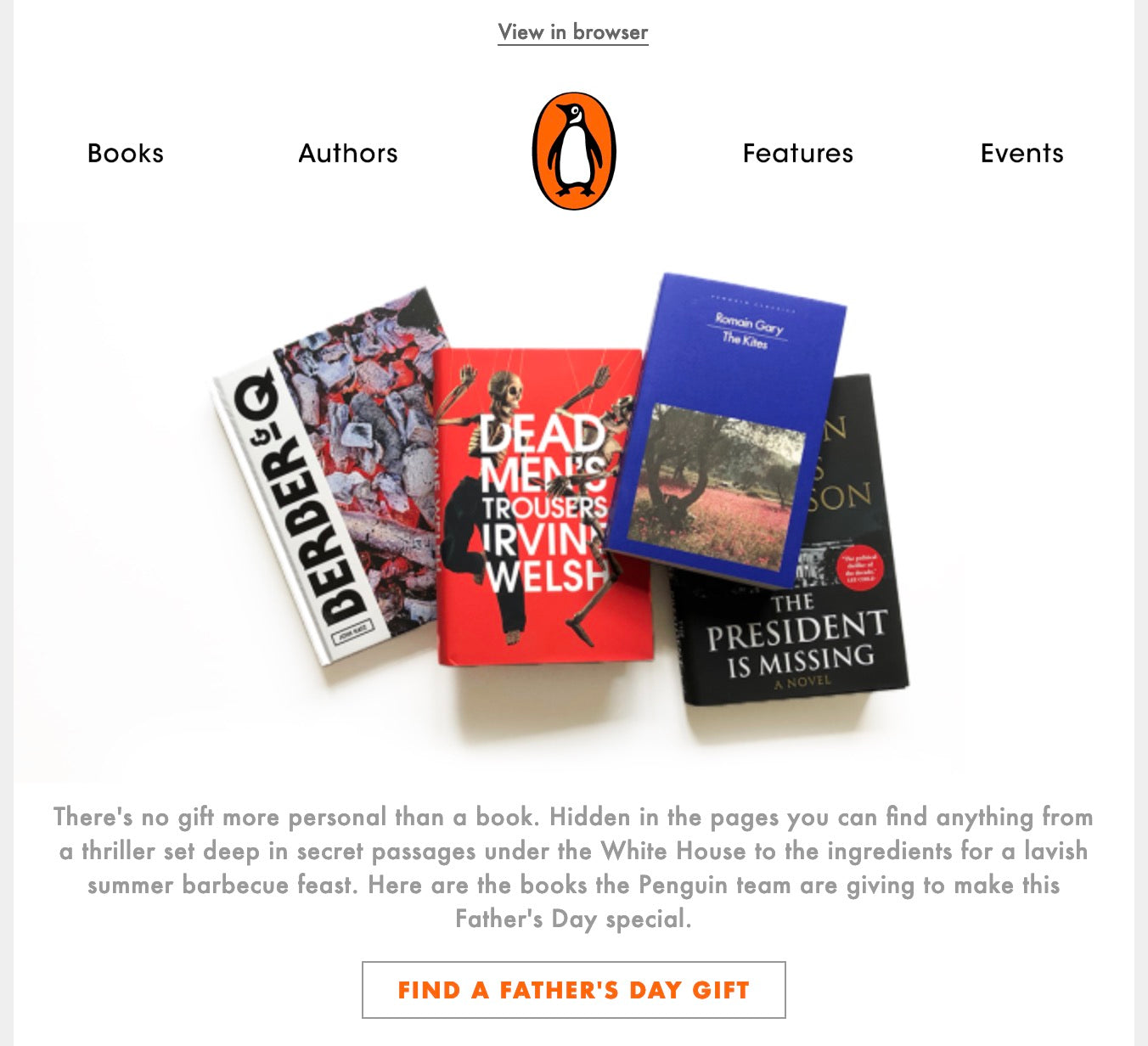
Newsletter
A regular newsletter can help with the important tasks of educating your customers and telling your brand story. Customer case studies and brand stories are an under-appreciated way of staying in contact and building closer connections with customers (and prospects) without relying on discounts or promotions.
In the example below, Uncommon Goods shares more information about the brand’s mission to make a positive impact on the world, specifically how the company supports ethical brands and artisans. It’s a smart way to form a stance and speak to customers who feel the same way.

Everyone loves a compelling story, so if you can find a notable one from a staff member, customer, or even your own business and life, consider using it as a topic for a newsletter. Maybe a customer used your fitness products to lose 50 pounds, or you could share what originally inspired you to start your business. Whatever the story is about, it should be both interesting and relevant to your brand.
Content update
Email is often the lifeblood for new content. If you use content marketing to educate current customers and reach new ones, consider including that content in a regular newsletter, or have new content sent out automatically over email, through RSS. When you’re able to make the investment, consider creating content that provides additional context for your new or updated products (e.g., grooming tips for beauty products).
3. Lifecycle emails
Lifecycle emails are powerful because they’re personal and only target a small segment of your subscribers with relevant messages based on their behavior.
There are a number of effective lifecycle (or triggered) emails even a new store owner can consider: cart abandonment emails, a welcome email series, second-order emails, and win-back campaigns. Each of these emails has the potential to make a significant impact on customer satisfaction and retention.
Shopping cart abandonment emails
The average shopping cart abandonment rate sits between 60% and 80%. That’s a lot of revenue left unrealized. Fortunately, you can win a few of those potential customers back. Abandoned cart emails typically can recover between 5% and 11% of otherwise lost sales.
Abandoned cart campaigns are the closest thing there is to a ‘quick win’ in ecommerce.
You may want to consider including an added incentive for completing a purchase, though this can coach shoppers into abandoning their carts for a discount. At the very least, use benefits-driven copy that nudges them back to your store with credit card in hand.
While plain text can be effective, you may want to visually show the products a customer added to their cart. In either case, remind them they were just moments away from a completed order, and focus on the reasons why they’d consider buying the product in the first place.
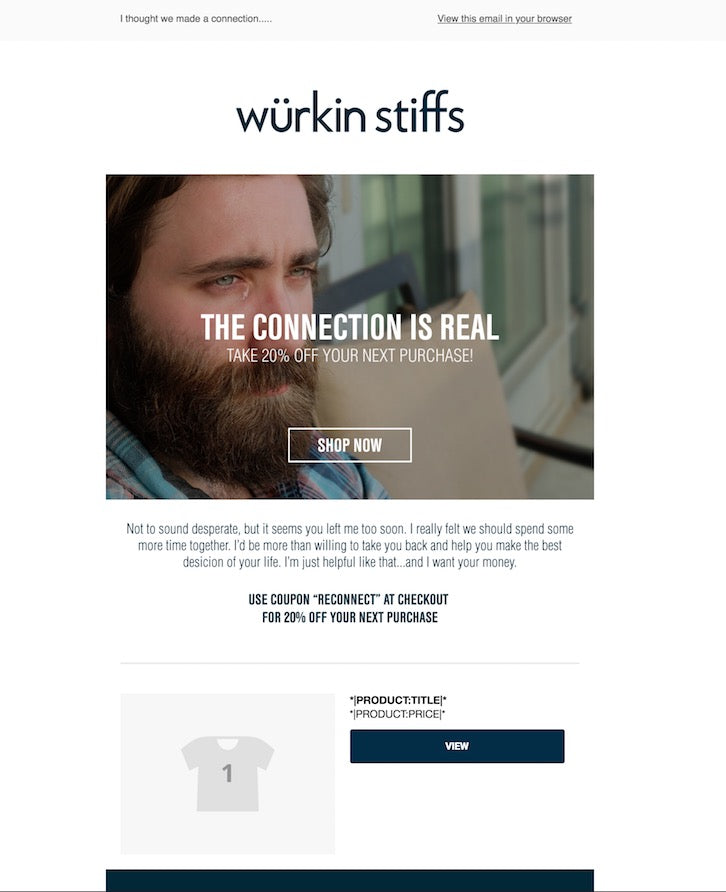
Würkin Stiffs sends a cart abandonment email with a 20% discount to encourage shoppers to finish checkout.
Ways to improve cart abandonment emails
- Put the main message in text format so customers will see it right away without having to enable images. Include a link back to their shopping cart so they can easily complete the transaction.
- Remind the customer about item(s) in their cart that are awaiting purchase so they can get excited about them again. Highlight specific features and show off high-quality product photos.
- Consider communicating a specific incentive to return to their cart, such as free shipping or discounts. If an item is running out of stock, let customers know as a courtesy while also instilling a sense of urgency.
- Use a clear, compelling call-to-action. Keep it concise and limit yourself to a single call. Multiple CTAs can distract from the action you really want the customer to take: completing their purchase.
Welcome email series
Welcome emails are what you receive when you submit your email address to an online store—you’ve likely seen them in your inbox after creating an account or joining a newsletter.
According to data from Omnisend, welcome emails have an average open rate of 45%. Though the data varies, first purchase automation generally produces 3-6 times more sales compared to a regular promotional email. In addition, though a series of welcome emails may perform better than a single send, engagement drops off after the first email in the series.
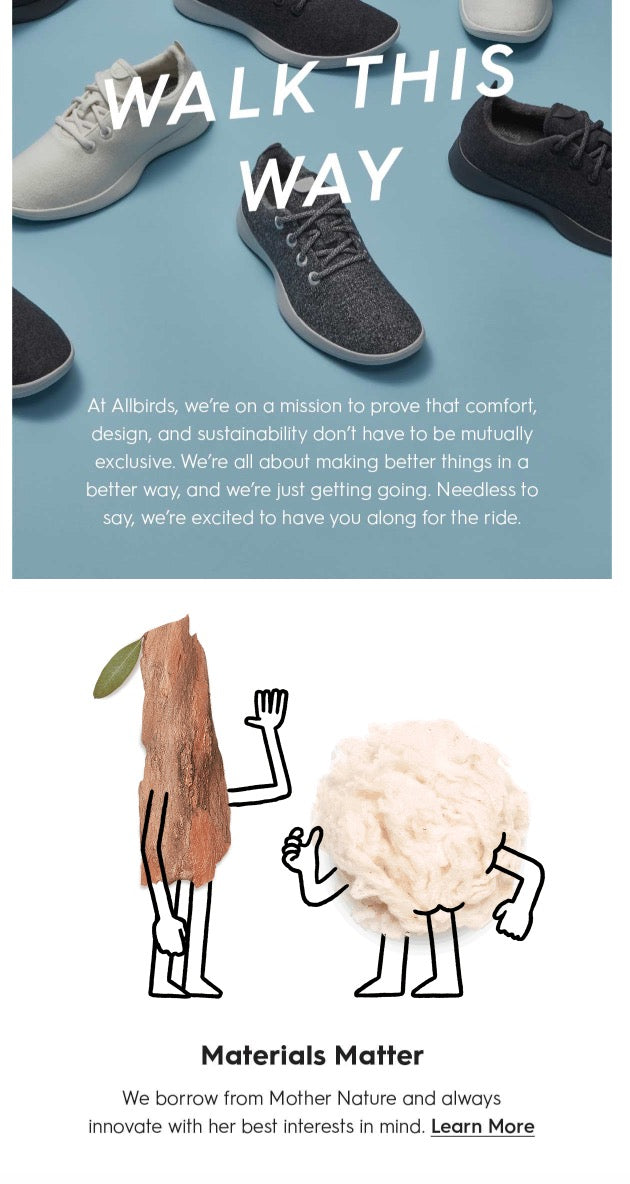
Ways to improve welcome emails:
- Provide value upfront. You don’t want to inundate customers with promotional messages during your only window of opportunity to create a strong first impression.
- Send your welcome email within minutes. Let’s say you incentivize joining your newsletter with a promo code for 10% off the customer’s next purchase. If someone is ready to purchase now and they don’t receive that promo code, you risk losing out on the sale for good.
- Set transparent expectations. Let subscribers change preferences easily, inform them what and how frequently you’ll be emailing new content, and remind them of how they ended up on your list in the first place.
Second order emails
Let’s say you sell video games. You might notice that, on average, a week after purchasing a video game console, 20% of customers purchase a second controller. Another 50% of customers don’t return at all.
In order to turn that 20% into 70%, you design a new customer or second order email campaign. Quite simply, when an order comes through for a video game console, an email campaign that showcases controllers triggers a week later.
This requires that you start looking at your customers and segmenting your data in Google Analytics. Some people will buy the controller when they buy the console, but there’s a sizable segment that doesn’t, which is where you have leverage.
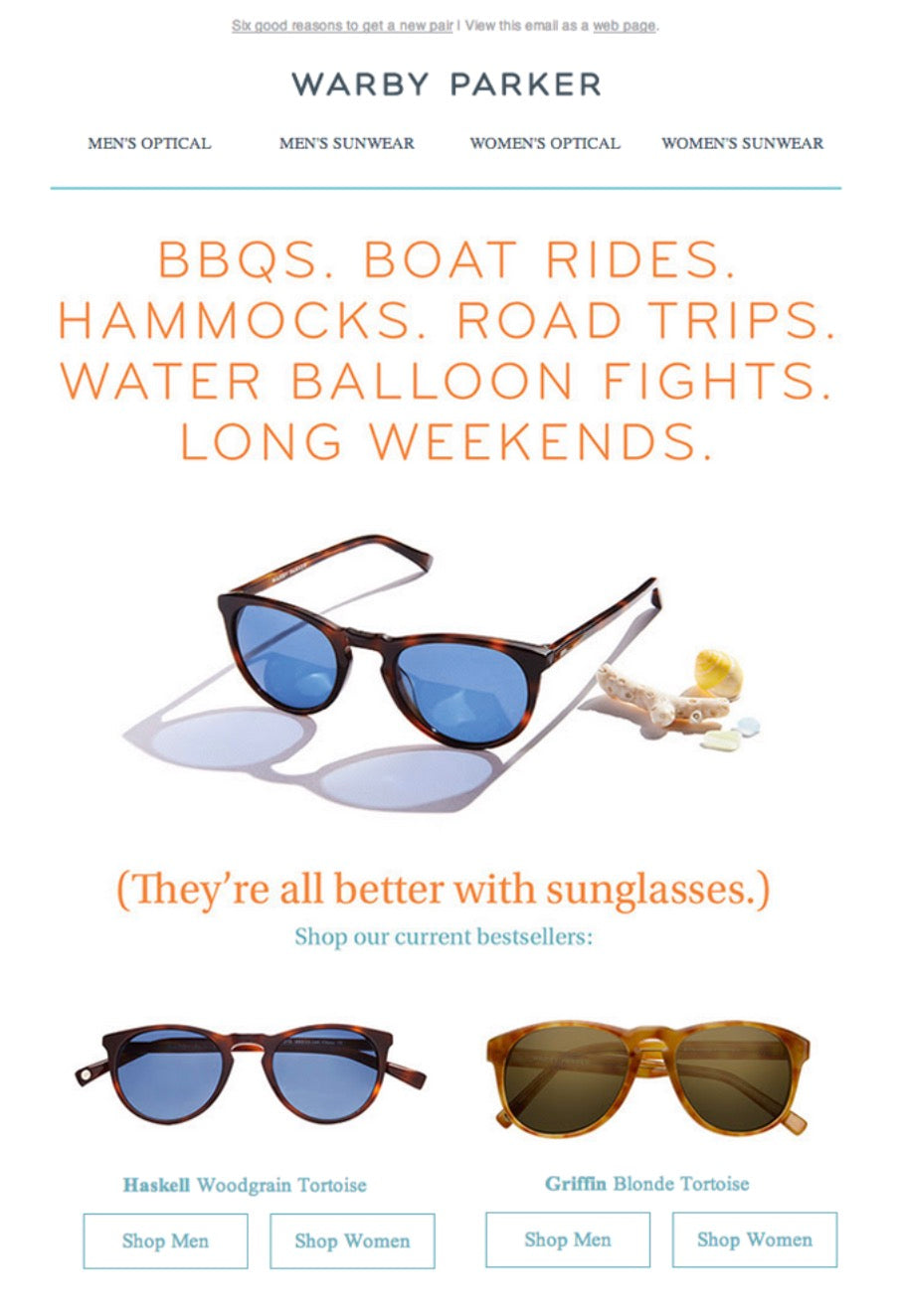
Ways to improve second order emails:
- Start with your two or three top-selling products. Are there any complementary products associated with your top-selling products?
- Try increasing their effectiveness with discount ladders. In this scenario, all you did was highlight a complementary product. You could also try offering a discount on that complementary product. You could also try offering a discount ladder: 5%, then 10% if they don’t bite, then 15% if they don’t bite, etc.
- Test campaigns based on your own data. No one can tell you what your top-selling products are or which products would be complementary to them or when to send the one-two punch campaign. These campaigns will look different for everyone.
Win-back series
Win-back email campaigns come in different shapes and sizes, but they’re all designed to lure lapsed customers back to positive purchasing behavior.
Let’s say you’ve done a bit of digging and you know that customers tend to come back and make their second purchase after 45 days. If 45 days come and go without a second purchase, you know it’s unlikely that customer will ever make a second purchase.
Or let’s say you’ve had an active customer who has purchased from you every 45 days or so for the last six months. Recently, he’s been MIA. No orders from the last 44 days. This is where a win-back campaign goes to work. An email would automatically be sent out after 45 days of no activity because you know, according to your store’s unique situation, that’s unusual for a healthy, active customer.
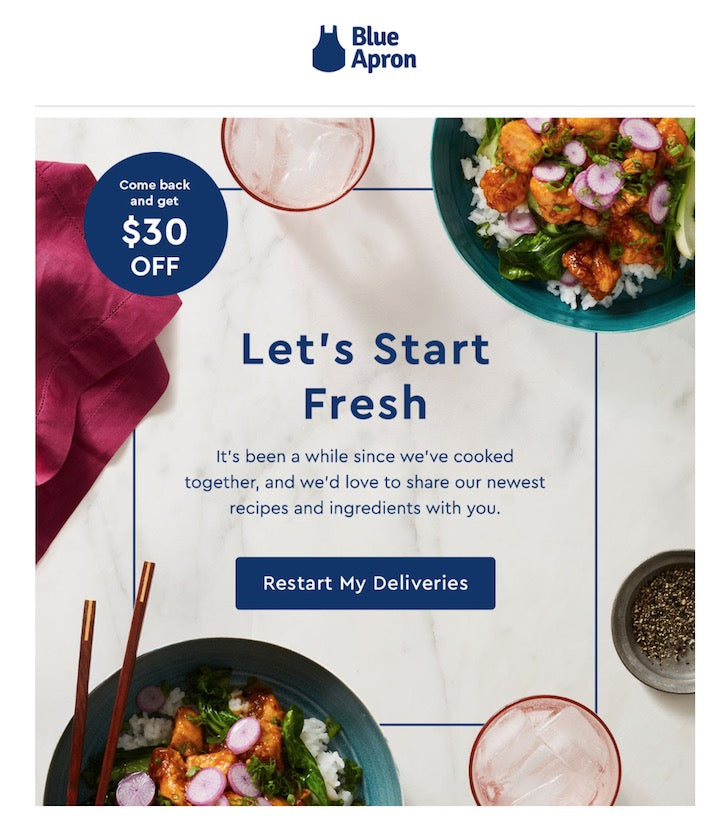
Ways to improve win-back emails:
- Test early so you don’t leave money on the table. Split test these emails to find out what the minimum amount you can offer without losing conversions is. Can you get away with 5% instead of 10%? 10% instead of 15%?
- After 90 days of inactivity, the outlook is not good. If someone goes three months without purchasing, the odds of them returning to purchase are not great. Though, this is definitely dependent upon your store and industry. Some stores simply have a long sales cycle. Just be aware that you will probably start experiencing diminishing returns at 90 days.
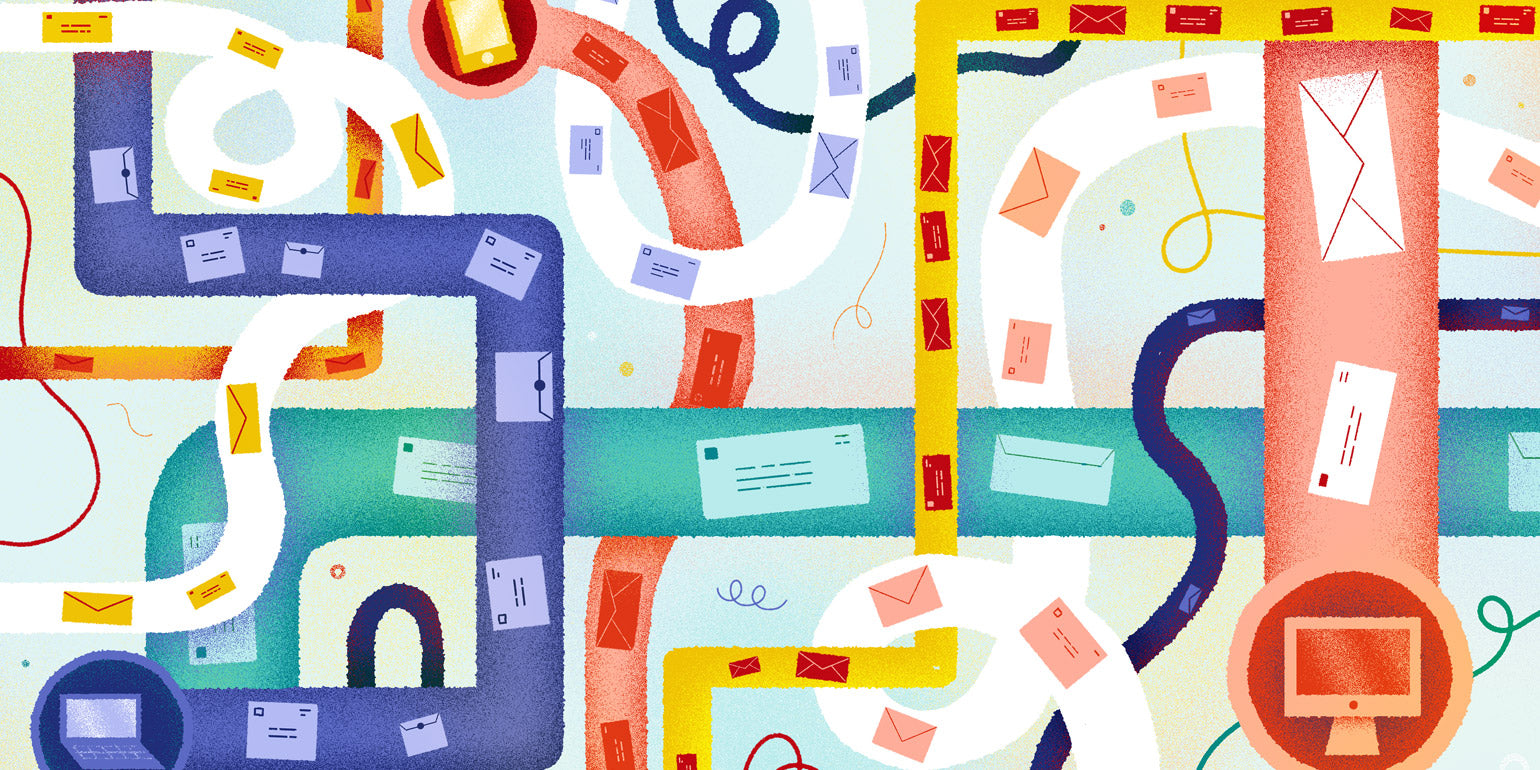
Foundational metrics to track email marketing performance
1. List size and growth
In his Shopify Academy course, AutoAnything CEO Drew Sanocki says, “To grow your email list is to grow your business.” Whether you’re collecting emails from customers or capturing emails from website visitors, the larger your email list, the more potential customers you can reach to grow sales—it’s the next best thing to revenue.
Keep track of this straightforward but important metric by using your email service provider to see how many new subscribers you’ve added on a weekly or monthly basis, or between your most recent broadcast emails.
2. Open and click-through rates
An open rate is a percentage that tells you how many successfully delivered emails in a campaigns were opened by subscribers. A standard open rate is 20%-30%. You will notice your open rate is usually higher when you’re first starting out. Your subject line plays a big role in your open rate, too—the more compelling the subject line, the higher the open rate.
A click-through rate is a percentage that tells you how many successfully delivered emails in a campaigns registered at least one click. A standard click-through rate is generally two to three times the conversion rate of your online store, maybe 5% or so. Why? Because you have a highly targeted group of people on your list who have opted in to your content. Your calls to action and images in your email play a big role in your click-through rate.
While open and click-through rates measure separate behaviors, together they tell you something about how engaging your emails are. When the numbers are lopsided—for example, if lots of people opened an email but few clicked the call to action—you can see what improvements are worth making.
Learn more: Email Marketing Best Practices: How to Improve (Almost) Every Email
3. Deliverability and list health
According to IBM Marketing Cloud, the mean global hard bounce rate is 0.47%. A hard bounce is an email that’s returned to the sender because of an invalid address. If the email does make it to your intended recipient, they still have the option to report the email as spam. If you’re consistently marked as a sender of spam you’ll hurt your deliverability rates for all subscribers.
Spam filters are fairly straightforward. There is a long list of factors emails are scored on. If the email’s score gets too high, it’s flagged as spam by the email server. Unfortunately, every server is different and constantly changing. So what’s marked as spam on one server might not be marked as spam on another. As a general rule, you’ll want to avoid:
- Being too “salesy” by using all caps, exclamation marks, and trigger words like “free”
- Big images with very little text, because many spam filters don’t recognize images
- Emailing old lists you haven’t properly maintained over the years
Human spam filters are even more complex. No one can tell you exactly what makes someone click the spam or abuse button, but there are some general rules. You’ll want to avoid buying lists or sending emails without explicit permission, being vague about when you’ll email, hiding the unsubscribe option or making the process of unsubscribing unnecessarily difficult, or leaving unengaged, inactive leads or customers on your list (though, you can and should eventually mount a reactivation campaign for those inactive leads).
Many email service providers, especially those that take deliverability seriously, consider a 0.1% complaint rate a reasonable threshold. That means for every 1,000 emails you send, no more than one person marks it as spam or abuse.
4. A/B test results
Running an A/B test means carving out three groups of recipients: an A group, a B group, and a C group. After sending two variations of an email to the A and B groups, you’ll use your analytics to decide which message performed better by way of generating more engagement or sales. Then, you’ll send the winning version, whether that’s A or B, to your final pool of recipients (C).
A/B testing lets you confidently send high-performing emails by testing specific messaging, design, and calls to action with a smaller segment of subscribers first.
5. Revenue
Revenue is, of course, how much money is coming in the door. What percentage of your store’s total revenue can be attributed to email marketing? Sanocki tells us many successful stores he’s seen get about 20% of their total revenue from their email channel.
The value of using green light benchmarks
Tracking the performance of your marketing on any channel where you invest time and money is essential, but obsessing over metrics is also an easy way to get distracted.
Instead, consider aiming for “green light benchmarks,” a concept created by Ramit Sethi. Once you’ve reached a certain threshold, you can give yourself the “green light” to move on to something else for a bit—there are always bigger fish to fry when growing a business. Sanocki recommends the following benchmarks for most of your promotional and lifecycle email campaigns:
- A 20% open rate, which says you’re sending relevant emails to the right people with interesting subject lines
- A 5% click-through rate, which says the content and offers in your emails are compelling enough to click
- A 20% of total store revenue from email marketing, which says email marketing as a channel is converting first-time customers and upselling existing customers enough to warrant further investment
Bonus: Drew Sanocki has also created a simple free template you can use to track the individual performance of your initial email marketing campaigns.
Lifecycle automation: the next level of email marketing
Marketing messages gain potency through relevancy, which means sending email based on a customer’s existing behavior—and where they are in the customer journey—is the ideal state. Since lifecycle marketing automation deserves its own lengthy guide, we’ll start with a brief introduction here.
To start talking about lifecycle marketing through email, we need to begin with RFM. Essentially, RFM is a database marketing term that can help you define your customer buckets. RFM stands for recency (R), frequency (F), and monetary value (M).
- Recency is the number of days since a subscriber or customer’s last purchase. An R0 purchased today. An R365 purchased a year ago.
- Frequency is the total number of times a subscriber or customer has purchased. An F0 has never ordered. An F10 has ordered ten times.
- Monetary value is a customer’s total spend—the sum of all his or her orders ever.
With these three metrics you can pinpoint and describe almost any stage in the customer lifecycle.
For example, what’s an R0 F0? Well, it’s someone who has never ordered but just joined your email list. How about an R7 F10 M1000? That’s probably a loyal buyer: 10 orders which total $1,000, the most recent being a week ago. And an R400 F10 M1000? Unfortunately, that’s a former loyal buyer, a “defecting customer,” who’s very far along in the customer lifecycle curve. She’s slipping away and hasn’t bought in more than a year.
R, F, and M are useful because they can define the metrics that will set rules in your email software. When you want to reach loyal buyers, you first have to define them, and R, F, and M are useful for that.
While there are a near-infinite number of segments you can create based on a customer’s existing behavior, there are five essential buckets you can start with first when outlining the customer lifecycle:
Segment 1: New subscribers
Your goal with brand new subscribers is to build trust, introduce your products, and get them to make their first purchase. In other words, to establish a relationship that turns them from an F0 (no purchases) into an F1 (first purchase).
Learn more: What I Learned Analyzing 60 Days of Emails from a Fast-Growing Ecommerce Brand
Segment 2: One-time buyers
Get them to buy a second time! This seems obvious, but it has serious implications for your email marketing strategy. Due to high customer acquisition costs, most retailers break-even on the first purchase, the F1, and it’s only on repeat purchases that they generate profits. And yet if you were to look at all your customers today, you’d probably have 80%–90% F1s. Put another way, 80%–90% single-purchase, marginally profitable customers.
So you can see it’s important to turn an F1 into an F2. Improving this area makes you money. A bounce-back email is an ideal campaign to run, or a campaign that delivers an offer on a product related to the product that was just purchased. After a customer buys a pillow, it’s a great time to send them an offer on bedsheets.
Segment 3: VIPs
Your “whales” are those customers who make large or consistent purchases from you. These customers are worth a lot and, better yet, they rarely require discounts to come back. To engage these customers, employ targeted email campaigns that court them and keep them buying—say and showcase how much you value their business, give them an 800 number if it makes sense, or offer a special loyalty program. And don’t forget to gather feedback on what they want to buy so you can sell it to them later.
Segment 4: Defecting customers
While these folks might have been enthusiastic customers at one point, for one reason or another they aren’t now. When a customer is slipping away, to potentially never purchase again, offering discounts to win them back can make financial sense. The perfect email for this segment is called a win-back, which should include an eye-catching offer with a deep discount used to entice them to return.
Segment 5: Cart abandoners
Earlier in this guide we shared just how valuable a simple cart abandonment campaign can be. Once that’s in place, you may want to test a series of emails that goes out over two weeks. Start with gentle reminders first and, if they don’t work, move on to greater incentives, like discounts. You’ll find that many of your recovered carts return before the discounts are even required.
In total, five simple segments, but as a basic strategy they cover the customer lifecycle from start to finish. Use R, F, and M to define these groups in your own email marketing tool, then build out and automate campaigns to target each valuable segment.
Push send and drive more sales
One of the best things about email marketing is it’s a low-risk channel to explore when you’re getting your feet wet. Start building a basic email list, set up your first cart abandonment campaign right away, and slowly iterate until you have a holistic strategy in place. There’s no better time than now to get started!
Illustrations by Axel Kinnear.
